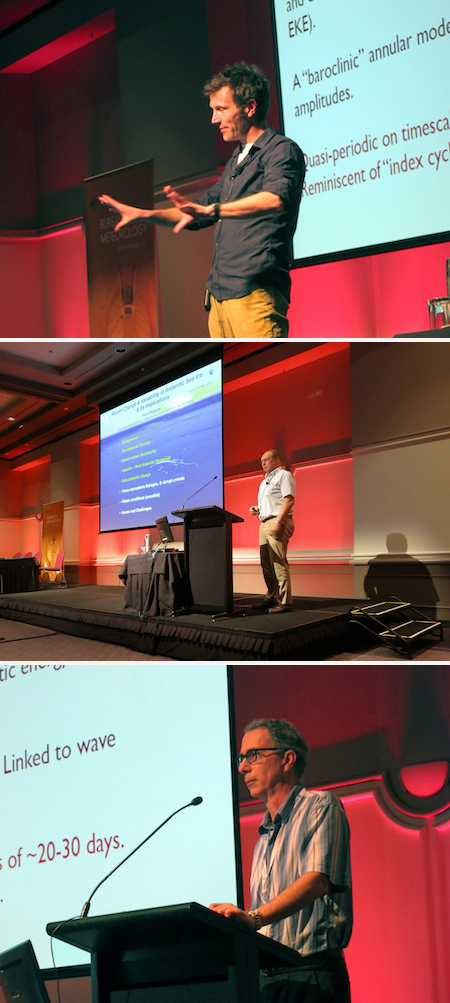Rough edges reveal the true value of science. [18 February 2014 | Peter Boyer]

AMOS speakers (top to bottom): David Thompson (Colorado State University), Rob Massom (Australian Antarctic Division, ACE-CRC), David Karoly (University of Melbourne)
For a good part of last week I was holed up in a Hobart conference centre with a few hundred scientists taking a hard look at the future of our climate. It was both sobering and reassuring.
These people are interesting, thoughtful, funny, and generally good company, as I’ve found many times at their gatherings going back decades. As always, the conversation both on the conference floor and between sessions was as enjoyable as it was stimulating.
This 2014 conference of the Australian Meteorological and Oceanographic Society (AMOS) put a spotlight on what was happening to the weather and climate of southern parts of the globe, especially the Australian region.
Science meetings are full of sceptics, which becomes obvious in the questioning of presenters and in conversations afterwards. Again and again you’re reminded that doubt is ever-present in science.
There’s also a strong sense of common purpose. There’s competition, but it’s open competition, because everyone involved knows that their investigation will get no-one’s approval if it isn’t completely transparent. Results count only if the method that achieved them is laid bare.
The AMOS meeting’s three-day program was divided into four streams containing a total of 224 separate talks plus a further 66 poster presentations: a total of close to 300 scheduled presentations. This was a conference on steroids, but then, so are all the ones I’ve seen.
The coverage was enormous, taking in hemispheric and regional weather-climate patterns, climate extremes, ocean mixing, currents and eddies, carbon cycles, Antarctic sea ice, coastal climate and the renewable energy potential from sun, wind and waves, among many other subjects.
The schedule obviously impressed the governor, Peter Underwood, who in opening the meeting remarked on the full program and queried whether some presenters might lack an audience. He needn’t have; all the sessions I visited were well-attended.
The transparency of science was clear from the opening plenary session, in which veteran CSIRO meteorologist Jorgen Frederiksen explored modes of climate variability, illustrated by a large number of southern hemisphere weather patterns over several decades.
Frederiksen is not a polished stage performer. He often seemed to forget that he was in a large room speaking to lots of people, though fortunately the audio system took care of that. But from where I sat, any shortfall in his presentation skills was more than made up for by a clear love for his subject, a deep and detailed knowledge about weather systems built up over a lifetime, and absolute sincerity in imparting this knowledge to his audience.
Similarly, other presenters I saw seemed a bit awkward, as if they were surprised to find themselves in front of an audience. Rough edges were everywhere. As a communicator I saw numerous cases where a bit of literary or graphic skill might have got a point across more effectively.
Most scientists have a way to go to approach the skill of a master of marketing or media. We need more of them to go public about their work, but in improving their presenting skills they should be careful not to sacrifice the openness and honesty that’s the hallmark of their profession.
Science isn’t about answers, but questions. It’s about unfinished business, rough edges. A high sheen can disguise a poor product underneath, while a rough-hewn presentation is open for all to see, exactly what’s needed by audiences interested not in style but content.
Science can’t be boxed up to suit this or that set of beliefs, or to serve a political agenda, or to please people who (like me) put it out there for public consumption. Some may find that annoying, but they should be reassured by it, because ideology is the death of science.
The potential for ideology to muddy the waters was evident in a public discussion around a finding by a team led by University of NSW climatologist Matthew England, published last week in the journal Nature Climate Change and discussed by England at the Hobart meeting.
Contrarian bloggers, having wrongly claimed that the Intergovernmental Panel on Climate Change (IPCC) agreed that global warming had stopped in 1998, said the England paper amounted to an admission to this warming “pause” and castigated him for inconsistency.
Natural variability dictates that climate doesn’t change smoothly, but in steps. The paper refers to a “hiatus” in surface temperatures since 2000, but explains that heat energy has been transferred from the surface into the ocean, which holds over 93 per cent of Earth’s heat energy.
Wind drives energy transfer between air and sea. England’s team found that a strengthening of equatorial trade winds in the Pacific Ocean allowed the ocean to absorb more heat energy, effectively lowering global average surface temperatures by 0.1 to 0.2C.
While surface temperatures remain the best guide to what’s happening to our climate, their susceptibility to natural variability makes them an obvious tool for discrediting the science.
If you want to imply that warming has stopped, you pick a period with a hot starting year, like 1998, which at the time was by far the warmest year ever recorded. Starting with any other year would have revealed a very different “trend”, as the IPCC pointed out in its 2014 report.
All the big global temperature databases show that surface temperatures from 1998 to 2013 continued to trend upward. The 17 warmest years on the 133-year thermometer record are the 17 years since 1996, of which 1998 is now just the third-warmest year, behind 2010 and 2005.
Like the meteorologists and oceanographers who made Hobart their home last week, we all have to live with rough edges because that’s the way the world is. Beware the slick, simple one-liners.
